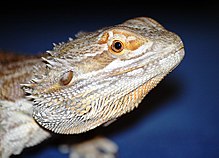Pogona
This article contains instructions, advice, or how-to content. (July 2011) |
| Pogona | |
|---|---|

| |
| Pogona vitticeps | |

| |
| Pogona vitticeps - detail of head | |
| Scientific classification | |
| Domain: | |
| Kingdom: | |
| Phylum: | |
| Class: | |
| Order: | |
| Suborder: | |
| Family: | |
| Subfamily: | |
| Genus: | Pogona
|
| Species | |
|
Pogona barbata | |
Pogona is a genus of lizards containing seven species, which are often known by the common name bearded dragons. The term "bearded dragon" is most commonly used to describe the Central Bearded Dragon. Members of this genus live in the arid, rocky, semi-desert regions and dry open woodlands of Australia. They are adept climbers, spending time on branches and in bushes and spend time near human habitation. Pogona bask on rocks and exposed branches in the mornings and afternoons. The species are found throughout Australia.[1]
Several species of this genus have been domesticated, especially Pogona vitticeps and are often kept as pets or exhibited.
Description
This section needs expansion. You can help by adding to it. (January 2011) |
The genus is in the subfamily Agaminae of the family Agamidae. Their characteristics include spiny scales arranged in rows and clusters. These are found on the throat, which can be expanded when threatened, and at the back of the head. These spiny scales are used to scare off predators, yet they are not very sharp. The species also displays a hand-waving gesture; this is to show submission between Dragons. They also have a head bobbing act to show dominance. They have the ability to change colour during rivalry challenges between males, and in response to temperature change and other stimuli, such as turning black to absorb heat. They can grow to the size of about 13 to 24 inches (330 to 610 mm).[1]
In captivity
Bearded dragons, agamid lizards of the genus Pogona, are often kept as pets, most commonly Pogona vitticeps, the Inland or Central Bearded Dragon. Pogona describes seven species naturally found in arid, semi-arid woodlands and rocky deserts in central Australia.
They are a popular species among children, because of their friendly and calm nature, along with the relative ease of caring for them.[2] Bearded dragons have broad triangular heads and flattened bodies, with adults reaching approximately 16 to 24 inches (410 to 610 mm) from head to tail and weighing 350 to 600 grams (10 to 20 oz).[3]
Diet

Bearded dragons are native to the central Australian desert, where food is often scarce. Bearded Dragons are omnivorous, capable of subsisting on a wide variety of food sources. In the wild they will eat just about anything they can catch.[1]
A typical captive bearded dragon's diet consists mostly of leafy greens, vegetables and non citrus fruits, supplemented regularly with insects. Crickets are the most popular feeder choice, but bearded dragons can also be fed other insects such as black soldier fly larvae, locusts, superworms, waxworms, silkworms, butterworms, grasshoppers and even certain varieties of roaches.[2] Young dragons require a significantly greater insect-to-plant matter ratio in their diets than adults.[4]
Not all insects are equally recommended as feeders, however. The mealworm, a popular feeder insect for other kinds of reptiles, has a hard chitin exoskeleton, which makes it difficult for dragons to digest. It is also relatively low in nutrients.[5] Waxworms and superworms can be given as occasional treats, but should be fed sparingly as they are extremely fatty. They are best used as food for undernourished or gravid bearded dragons. The size of the insect being fed must also be taken into account. The general rule of thumb is that the food being provided must not be larger than the space between the animal's mouth endings; feeding anything larger could lead to fatal impaction. The distance between the eyes is the quickest way to assess the space between mouth endings.[6]
Suitable leafy green vegetables include collard greens, spring greens, escarole, turnip greens, mustard greens, parsley and carrot tops.[7] Dragons may also eat orange-fleshed squashes, pattypan squash, pumpkins, green beans, peas, carrots, yams or their tops, beetroot, alfalfa (lucerne), celery, rosemary, oregano and basil. Suitable flower greens include dandelion greens, nasturtium, hibiscus, pansies, carnations and rose petals. Suitable fruit includes grapes, strawberries, raspberries, apples, pears, peaches, melons, papayas, blueberries and mangoes.[2]
Poisonous and dangerous foods

Insects captured in the wild are not recommended, due to the increased risk of parasitic exposure and viruses. Fireflies and all other animals with bioluminescent chemicals[8] are quickly fatal to bearded dragons. Also anything that has a high amount of fiber in it is not recommended because it counteracts calcium which is vital to healthy bone growth.
External links
References
- ^ a b Browne-Cooper, Robert (2007). Reptiles and Frogs in the Bush: Southwestern Australia. University of Western Australia Press. p. 160. ISBN 978-1-920694-74-6.
Pogona minor minor, Abrolhos Bearded Dragon
{{cite book}}: Cite has empty unknown parameters:|month=and|chapterurl=(help); Unknown parameter|coauthors=ignored (|author=suggested) (help) - ^ a b c Jaeger, Jeremiah. "Bearded Dragons Care Sheet". beardeddragon.org. Retrieved 11 September 2012.
- ^ "Hades Dragons". hadesdragons.co.uk. Retrieved 11 September 2012.
- ^ Daichu, Robert and Victoria (26 May 2007). "Frequently Asked Questions". Retrieved 11 September 2012.
- ^ Tosney, K. W. (January 2004). "Caring for an Australian Bearded Dragon". University of Miami. Retrieved 11 September 2012.
- ^ Sleeis, Alex; Bushnell, Denise (7 July 2006). "Impaction in Bearded Dragons". beardeddragons.org. Retrieved 11 September 2012.
- ^ Beautiful Dragons. "Nutrition Content". beautifuldragons.com. Retrieved 11 September 2012.
- ^ "Two Cases of Firefly Toxicosis in Lizards". Cornell University. Retrieved 11 September 2012.
{{cite web}}: Unknown parameter|coauthors=ignored (|author=suggested) (help)
